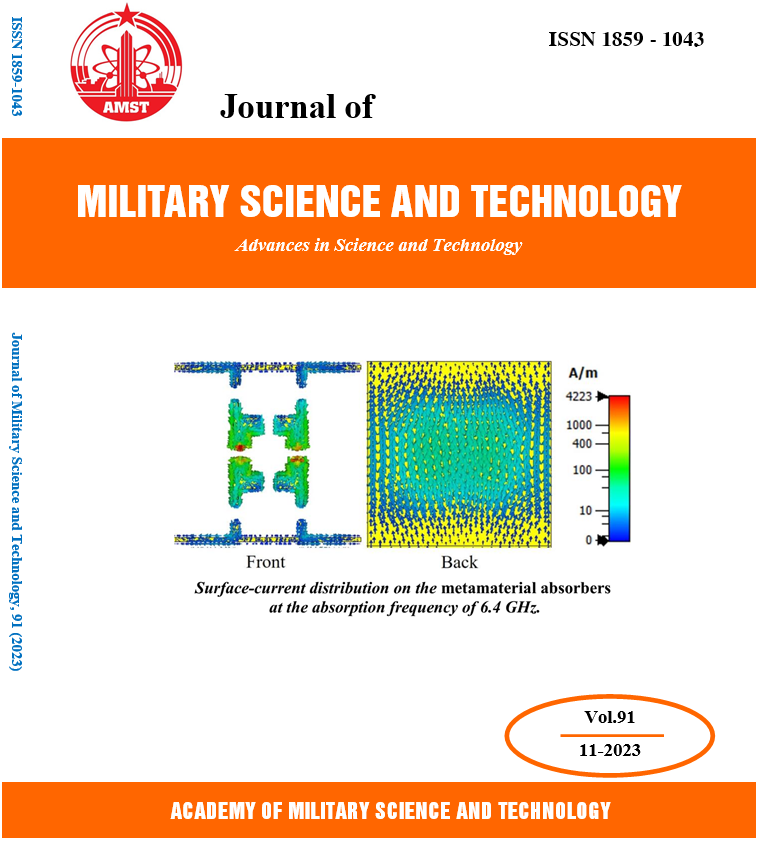Low power consumption gas sensor based on In2O3 nanowires in detecting hazardous gases
421 viewsDOI:
https://doi.org/10.54939/1859-1043.j.mst.91.2023.54-62Keywords:
Self-heating; In2O3 nanowire; CVD.Abstract
Recently, gas-sensing devices have been applied popularly in a ton of distinct areas, such as environmental monitoring, breath analysis, food storage, and detectors for both indoor and outdoor hazardous gases. Many efforts have been studied the novel generation sensor that consists of the advantages, i.e. low power consumption, low-cost, and flexibility. One of the potential strategies to deal with this issue is self-heating. In this study, the self-heated In2O3 nanofibers-based gas sensor was synthesized and fabricated via a chemical vapor deposition (CVD) combined with drop casting the as-prepared In2O3 nanowires on the IDE electrode. The sensor indicates a high response toward H2S at the supplied power of 1200 µW (Rg /Ra ~ 1.35). This is attributed to the length of single In2O3 nanowires (NWs), which provides a great pathway for electron transfer. The remarkable enhancement performance of the sensor is considered the first – step in the development of smart sensing devices.
References
[1]. L. Xiao, S. Xu, G. Yu, and S. Liu, “Efficient hierarchical mixed Pd/SnO2 porous architecture deposited microheater for low power ethanol gas sensor,” Sensors Actuators B Chem., vol. 255, pp. 2002–2010, (2018), doi: 10.1016/j.snb.2017.08.216. DOI: https://doi.org/10.1016/j.snb.2017.08.216
[2]. Y.-J. Hsiao, Z.-H. Shi, Y. Nagarjuna, Z.-Y. Huang, T.-Y. Lai, and S. Wu, “Double-Layered NiO/SnO2 Sensor for Improved SO2 Gas Sensing with MEMS Microheater Device,” ECS J. Solid State Sci. Technol., vol. 11, no. 5, p. 057002, (2022), doi: 10.1149/2162-8777/ac71c7. DOI: https://doi.org/10.1149/2162-8777/ac71c7
[3]. V. Kumar, S. M. Majhi, K.-H. Kim, H. W. Kim, and E. E. Kwon, “Advances in In2O3-based materials for the development of hydrogen sulfide sensors,” Chem. Eng. J., vol. 404, p. 126472, (2021), doi: 10.1016/j.cej.2020.126472. DOI: https://doi.org/10.1016/j.cej.2020.126472
[4]. Z. Li et al., “Significantly enhanced temperature-dependent selectivity for NO2 and H2S detection based on In2O3 nano-cubes prepared by CTAB assisted solvothermal process,” J. Alloys Compd., vol. 816, p. 152518, (2020), doi: 10.1016/j.jallcom.2019.152518. DOI: https://doi.org/10.1016/j.jallcom.2019.152518
[5]. C. Zhang, Y. Luo, J. Xu, and M. Debliquy, “Room temperature conductive type metal oxide semiconductor gas sensors for NO2 detection,” Sensors Actuators A Phys., vol. 289, pp. 118–133, (2019), doi: 10.1016/j.sna.2019.02.027. DOI: https://doi.org/10.1016/j.sna.2019.02.027
[6]. F. Rasch et al., “Highly selective and ultra-low power consumption metal oxide based hydrogen gas sensor employing graphene oxide as molecular sieve,” Sensors Actuators B Chem., vol. 320, p. 128363, (2020), doi: 10.1016/j.snb.2020.128363. DOI: https://doi.org/10.1016/j.snb.2020.128363
[7]. J.-H. Kim, A. Mirzaei, H. W. Kim, and S. S. Kim, “Pd-functionalized core-shell composite nanowires for self-heating, sensitive, and benzene-selective gas sensors,” Sensors Actuators A Phys., vol. 308, p. 112011, (2020), doi: 10.1016/j.sna.2020.112011. DOI: https://doi.org/10.1016/j.sna.2020.112011
[8]. J. Seo, Y. Lim, and H. Shin, “Self-heating hydrogen gas sensor based on an array of single suspended carbon nanowires functionalized with palladium nanoparticles,” Sensors Actuators B Chem., vol. 247, pp. 564–572, (2017), doi: 10.1016/j.snb.2017.03.038. DOI: https://doi.org/10.1016/j.snb.2017.03.038
[9]. S. M. Majhi, A. Mirzaei, H. W. Kim, S. S. Kim, and T. W. Kim, “Recent advances in energy-saving chemiresistive gas sensors: A review,” Nano Energy, vol. 79, p. 105369, (2021), doi: 10.1016/j.nanoen.2020.105369. DOI: https://doi.org/10.1016/j.nanoen.2020.105369
[10]. H. M. Tan et al., “Novel Self-Heated Gas Sensors Using on-Chip Networked Nanowires with Ultralow Power Consumption,” ACS Appl. Mater. Interfaces, vol. 9, no. 7, pp. 6153–6162, (2017), doi: 10.1021/acsami.6b14516. DOI: https://doi.org/10.1021/acsami.6b14516
[11]. E. Strelcov, S. Dmitriev, B. Button, J. Cothren, V. Sysoev, and A. Kolmakov, “Evidence of the self-heating effect on surface reactivity and gas sensing of metal oxide nanowire chemiresistors,” Nanotechnology, vol. 19, no. 35, p. 355502, (2008), doi: 10.1088/0957-4484/19/35/355502. DOI: https://doi.org/10.1088/0957-4484/19/35/355502
[12]. C. Fàbrega, O. Casals, F. Hernández-Ramírez, and J. D. Prades, “A review on efficient self-heating in nanowire sensors: Prospects for very-low power devices,” Sensors Actuators B Chem., vol. 256, pp. 797–811, (2018), doi: 10.1016/j.snb.2017.10.003. DOI: https://doi.org/10.1016/j.snb.2017.10.003
[13]. J.-Y. Kim, J.-H. Lee, J.-H. Kim, A. Mirzaei, H. Woo Kim, and S. S. Kim, “Realization of H2S sensing by Pd-functionalized networked CuO nanowires in self-heating mode,” Sensors Actuators B Chem., vol. 299, p. 126965, (2019), doi: 10.1016/j.snb.2019.126965. DOI: https://doi.org/10.1016/j.snb.2019.126965
[14]. J.-H. Kim, A. Mirzaei, J. H. Bang, H. W. Kim, and S. S. Kim, “Selective H2S sensing without external heat by a synergy effect in self-heated CuO-functionalized SnO2-ZnO core-shell nanowires,” Sensors Actuators B Chem., vol. 300, p. 126981, (2019), doi: 10.1016/j.snb.2019.126981. DOI: https://doi.org/10.1016/j.snb.2019.126981
[15]. T. M. Ngoc et al., “Self-heated Ag-decorated SnO2 nanowires with low power consumption used as a predictive virtual multisensor for H2S-selective sensing,” Anal. Chim. Acta, vol. 1069, pp. 108–116, (2019), doi: 10.1016/j.aca.2019.04.020. DOI: https://doi.org/10.1016/j.aca.2019.04.020
[16]. B. Zhang et al., “High-performance room temperature NO2 gas sensor based on visible light irradiated In2O3 nanowires,” J. Alloys Compd., vol. 867, p. 159076, (2021), doi: 10.1016/j.jallcom.2021.159076. DOI: https://doi.org/10.1016/j.jallcom.2021.159076
[17]. Y. Che, G. Feng, T. Sun, J. Xiao, W. Guo, and C. Song, “Excellent gas-sensitive properties towards acetone of In2O3 nanowires prepared by electrospinning,” Colloid Interface Sci. Commun., vol. 45, p. 100508, (2021), doi: 10.1016/j.colcom.2021.100508. DOI: https://doi.org/10.1016/j.colcom.2021.100508
[18]. A. O. Bokuniaeva and A. S. Vorokh, “Estimation of particle size using the Debye equation and the Scherrer formula for polyphasic TiO 2 powder,” J. Phys. Conf. Ser., vol. 1410, no. 1, p. 012057, (2019), doi: 10.1088/1742-6596/1410/1/012057. DOI: https://doi.org/10.1088/1742-6596/1410/1/012057
[19]. N. D. Chinh, N. Van Toan, V. Van Quang, N. Van Duy, N. D. Hoa, and N. Van Hieu, “Comparative NO2 gas-sensing performance of the self-heated individual, multiple and networked SnO2 nanowire sensors fabricated by a simple process,” Sensors Actuators B Chem., vol. 201, pp. 7–12, (2014), doi: 10.1016/j.snb.2014.04.095. DOI: https://doi.org/10.1016/j.snb.2014.04.095
[20]. D. N. Son et al., “A novel design and fabrication of self-heated In2O3 nanowire gas sensor on glass for ethanol detection,” Sensors Actuators A Phys., vol. 345, p. 113769, (2022), doi: 10.1016/j.sna.2022.113769. DOI: https://doi.org/10.1016/j.sna.2022.113769
[21]. Y. Wang et al., “Room temperature H2S gas sensing properties of In2O3 micro/nanostructured porous thin film and hydrolyzation-induced enhanced sensing mechanism,” Sensors Actuators B Chem., vol. 228, pp. 74–84, (2016), doi: 10.1016/j.snb.2016.01.002. DOI: https://doi.org/10.1016/j.snb.2016.01.002







